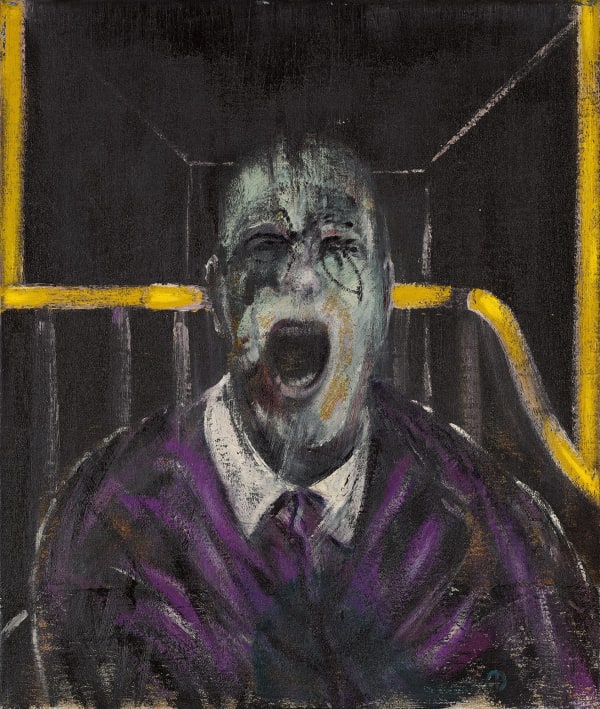-
Francis Bacon Prints For Sale.
Francis Bacon's art is a deep exploration of the human condition told through the revolutionary lens of a true genius. His distorted and contorted figures explore aspects religion, mythology & the deeply personal. Explore our latest Francis Bacon prints for sale at Guy Hepner, Bacon dealers since 2007.
Discover authentic Francis Bacon signed prints for sale below.
-
Works

Francis Bacon
Three Studies for a Self Portrait, 1981Three lithographs in colors printed on one sheet of Arches wove paper
Signed in pencil18 5/8 x 40 3/4 in
47.2 x 103.5 cmEdition of 150Copyright The ArtistFrancis Bacon’s After Three Studies for a Self-Portrait (1979) is a stark and haunting triptych that delves into the fractured psyche of the artist. Created several years after the tragic...Francis Bacon’s After Three Studies for a Self-Portrait (1979) is a stark and haunting triptych that delves into the fractured psyche of the artist. Created several years after the tragic suicide of his lover George Dyer in 1971—a loss that haunted Bacon for the rest of his life—the work serves as both a meditation on mortality and a raw exploration of identity in flux. Composed of three closely cropped, distorted views of Bacon’s face emerging from a void-like black background, the piece reflects deep introspection and existential unrest.
Although Bacon was nearing seventy at the time of its creation, the portraits avoid any overt depiction of ageing. Instead, the face appears strangely suspended in a kind of timeless vacuum—neither youthful nor aged, but rather outside the normal passage of time. This visual ambiguity underscores Bacon’s ambivalent relationship with mortality. His own image becomes a symbol of both presence and erasure, animated by the desire to confront death while simultaneously resisting its finality.
The triptych format—a structure Bacon returned to repeatedly throughout his career—creates a rhythm of repetition and variation, allowing for multiple interpretations of the self. Here, the three panels offer subtly different angles of Bacon’s face, none of which cohere into a singular, unified identity. This fragmentation suggests a disintegration of selfhood, as though Bacon is presenting not one person but three psychological aspects of the same being. The distortions applied to the facial features—twisted mouths, blurred contours, and asymmetrical expressions—speak to his deep dissatisfaction with his appearance and his ongoing struggle to capture an authentic self-image.
Bacon’s choice of a dark, nearly monochromatic palette further contributes to the claustrophobic atmosphere. The heads appear to float in a black void, stripped of any context or environment, intensifying their isolation. This stark presentation shifts all focus onto the flesh itself—distorted, bruised, and manipulated—emphasizing the vulnerability and fragility of human existence. The absence of any body or background enhances the psychological intensity, making each portrait not a record of a face, but a manifestation of inner turmoil.
What makes After Three Studies for a Self-Portrait particularly poignant is the tension between exposure and concealment. Bacon was notoriously guarded in his private life, and his self-portraits, while seemingly confessional, are filtered through layers of abstraction. Rather than painting from life, Bacon often relied on photographs taken by friends or by professional photographers such as John Deakin. This detachment allowed him to manipulate his own image with greater freedom—stretching, compressing, and distorting it in ways that might have felt too vulnerable had he painted from direct observation. In doing so, he shielded the rawest parts of himself while still grappling openly with emotion, trauma, and the passage of time.
There’s a theatrical element to the work, too. The heads, isolated against a black backdrop and lit as if by spotlight, seem staged—spectral actors performing anguish, uncertainty, and self-reckoning. The triptych reads as both confession and performance, a visual soliloquy in which Bacon addresses the viewer without ever truly revealing himself. We are confronted with the image of a man wrestling with grief, memory, and the disintegration of identity, yet the deeper emotional core remains just out of reach.
This interplay between visibility and opacity, between flesh and shadow, lies at the heart of Bacon’s self-portraiture. In After Three Studies for a Self-Portrait, the viewer becomes a participant in this process of existential inquiry, invited to witness the fragmentation of self without the comfort of resolution. Each panel operates as a psychological mirror, reflecting not only Bacon’s internal state but also a broader meditation on what it means to be human: flawed, impermanent, and in constant flux.
Ultimately, this triptych stands as a testament to Bacon’s ability to fuse personal trauma with universal themes. His use of distortion and repetition does not alienate the viewer, but rather draws us into the emotional gravity of the work. In confronting his own image, Bacon confronts the deeper anxieties that define the human condition—mortality, identity, isolation, and the lingering shadow of loss.
For more information on Francis Bacon’s After Three Studies for a Self-Portrait or to buy Francis Bacon’s After Three Studies for a Self-Portrait contact our galleries using the form below.Overview"The job of the artist is always to deepen the mystery".
Francis Bacon is one of the most important artists of the 20th century and post-war movements. Arguably one of the finest and most celebrated artists of his generation, Bacon holds a pivotal role in contemporary art through his revolutionary approach to his craft. One of the great explorers of the human condition Francis Bacon and his art, touch on fateful mix of mythology, religion, love and death, and document our joys, sorrows and pains perhaps better than any other artist before or since.
The imagery of Bacon is one of pure expression rejecting the prevailing artistic style of abstraction of the era, in favor of a distinctive and disturbing realism and his distorted forms convey a sense of both beauty and despair. The dichotomy in Bacon’s prints and imagery can be seen through his raw use of violent, yet delicate colors as well as the marriage he makes between the figurative and abstract. It is this soft balance between the brutal and the subtle, the violent and the soft and happiness and anguish that make Francis Bacon’s art so important and collectible. A master of painting, and known for his large scale canvases, Bacon combines seemingly disparate tectures, colours and forms to ceate a whirlwind of emotion conveying and reaching the heart of his subjective matter. Equally so Franci Bacon's print output, often as apres, lithographs or signed prints, offer his most popular subjects including Pope Francis and his famous triptychs.
Whether new to collecting Francis Bacon prints or an experienced collector, Guy Hepner can help. Since 2007 we have assisted clients across the world to buy Francis Bacon prints in confidence. Whether iconic triptych, lithographs or apres, our experienced and knowledgeable team are on hand to help you achieve your collecting goals. From our New York and London galleries, offer a wide selection of authentic Francis Bacon prints for sale.
Contact info@guyhepner.com for our latest Francis Bacon prints for sale or to buy Francis Bacon original art. News
News-

London’s Frieze Week Record Breakers
A Guide to a Blockbuster Week of Sales October 20, 2025London’s marquee auction houses just concluded a blockbuster week of contemporary art sales, coinciding with the Frieze art fair. In a series of evening auctions...Read more -

A Collector’s Guide to Francis Bacon Prints
Why Collect Bacon March 14, 2025Francis Bacon remains one of the most powerful and influential artists of the 20th century. His raw, visceral works depicting the human form in distorted,...Read more




